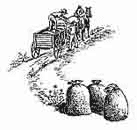
46
William Simmerwell, who had a home of his own near Auburn, was interested in starting a milling business. He and a friend had brought machinery for a combination saw and grist mill from Alton, Illinois, and asked me to help run it. I had now been on his father's farm just a year, but the missionary considered this a useful project and urged me to take the job.
Mills, indispensable to the growth of pioneer settlements, were springing up all over the state. By 1860 there were sixty-two water-powered mills in Kansas, as well as many that ran by steam. The new Auburn mill was one of the latter. It kept us busy from the start.
My first task was a humble one—carrying sawdust; but before long I was working the running lathe, the saw, and the engine. It took a watchful eye to keep the boilers filled with steam, leather belts tight around the pulleys, and the shining bandsaw ready for its first bite into a walnut log.
Walnut was the favorite building material, and it was abundant. We sawed it into truss timbers, girders, columns, and planks. Shingles, clapboards, and laths were usually split by hand. Window and door frames and other parts, such as windowpanes, nails, and hardware, were bought in Leavenworth, the trading outpost for our region. Five days were required to make the round trip with horses, and six with oxen.
Indians and white men within a hundred-mile radius brought their corn, wheat, and barley to be ground at the47
Auburn mill. During rush periods, we did sawing in the daytime and grinding at night. As engineer I worked both day and night shifts, drawing double pay.
One branch of the Santa Fe Trail passed through Auburn, then a town of some four hundred. There were an excellent 120-foot well for watering horses, and two stores, two blacksmith shops, a harness shop, a broom factory, a concrete schoolhouse, and a three-story hotel. The third story of this last building was used as a public hall and ballroom, in which four cotillions could occupy the floor at one time.
In 1859 the citizens of Auburn invited Colonel James H. Lane to be the main speaker at a Fourth of July celebration. It was his magnetic oratory that had helped in arousing the North to action, and he was still making eloquent appeals for the right of Kansas to enter the Union as a free state. When he arrived at Auburn, the Colonel was accompanied by his daughter. He delivered a stirring speech, followed by a ball that lasted till midnight.
An old stone barn in Auburn was credited with having saved the town from Indians who once came riding over the hill from the north, intent on making an attack. When they saw the long narrow building with its rows of small windows on the north and south sides, they decided that it was a fort and turned away.
Since early territorial days, the Independent Order of Good Templars had been working for prohibition in Kansas, with Lawrence as one of its strongholds. When a lodge was formed in Auburn, I was made chief, although I was only seventeen at the time. The Good Templars48
later became a potent factor in furthering the temperance movement in Kansas.
For more than a year now I had been sending my parents glowing accounts of life on this frontier, where any quantity of fertile land could be had for a song. Instead of urging me to return to Ohio at the end of my first two years, they decided to sell the farm and come west themselves. Eventually all of their children made Kansas their home.
Upon reaching Kansas City, Father bought a wagon and ox team to transport his family and household goods across the plains to Auburn. I had found a farm for him on Six Mile Creek, not far from the Simmerwell place, where he could also carry on his trade as a cobbler. My parents were glad to meet those who had befriended me.
One of the first questions I asked Father was, "Did anyone find my skates?"
A friend of mine, he said, had followed the precarious route I had taken along the barn rafters and succeeded in untying and rescuing them. I hope they brought as much pleasure to this pal as they had given me.
The drought of 1860 that faced my parents soon after their arrival might well have discouraged less hardy souls. Many other newcomers lost all faith in Kansas and quit their claims on the flat, hot, windy, dusty prairies. For nearly eighteen months no rain fell; creeks dried up and crops withered. Practically everyone who remained was dependent on aid from societies in the east for food and clothing. Through a distribution center in Atchison, one could get shelled corn, navy beans, dried apples, cornmeal, hominy, and salt pork. Some four thousand tons of49
provisions were shipped into the territory during this period of drought.
Our milling business declined to such an extent that the mill was finally shut down. One night the engine, boiler, and grinding machines all disappeared. Forty years later I discovered the identical parts in Louisville, a town north of Wamego. With work now at a standstill, I joined some other boys in a wolf hunt near Dighton and a trapping expedition on Walnut Creek near the present town of Great Bend. Our party comprised nine persons at the start, but only two remained to complete the hunt. In one night we killed forty wild animals, all but two being mountain wolves.
